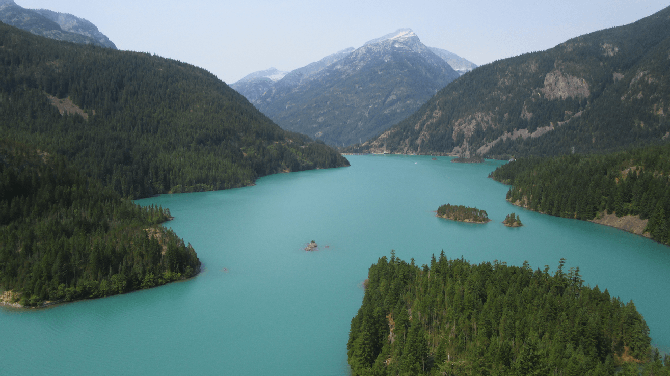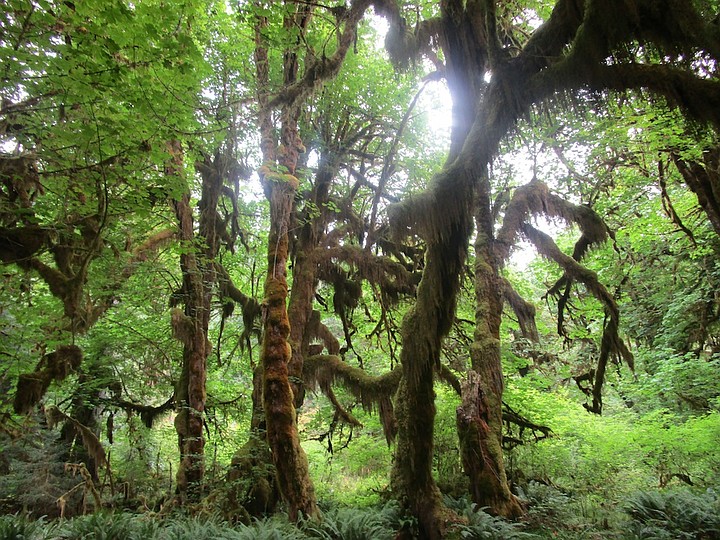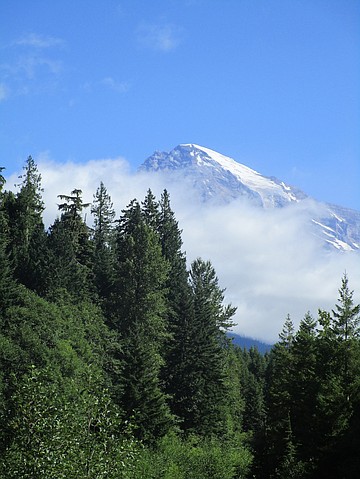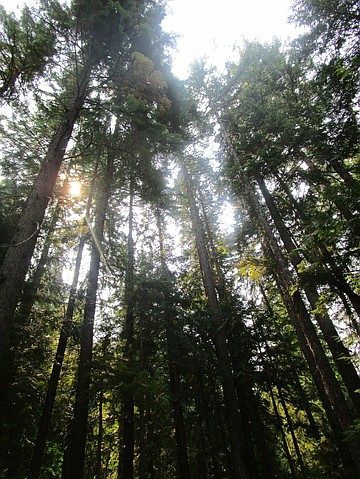 Facebook
Facebook
 X
X
 Instagram
Instagram
 TikTok
TikTok
 Youtube
Youtube

I paused on the winding Hall of Mosses Trail in Olympic National Park's verdant Hoh Rainforest. Gazing at the oddly shaped trees that seemed concocted out of an imagination meshing Tolkien and Tim Burton, I absorbed my surroundings with a quiet awe.

For a few days now on my sojourn through Washington’s three national parks, I'd been continually clicking photos. But I was in no mood now to fiddle with my camera. I wanted to fully absorb the moment through all my senses. I had never, in one day, explored a rainforest, traversed a rocky beach, and taken in mountain vistas. A visit to Olympic National Park allowed me to experience all three ecosystems in one day.
Olympic was just one of my visits in a nature odyssey across the state of Washington. Aside from California and Utah, it's hard to find a state that has three more exquisite national parks than those Washington is blessed with. Olympic, Mount Rainier and North Cascades are all worth devoting at least a week to. Yet each of them can also be enjoyed on separate day trips from Seattle.
I visited all three in one memorable road trip.
With its diversity and over 200 miles of trails, Olympic National Park has something for nature lovers of all persuasions. Primary ecosystems include temperate rain forest, alpine tundra and ocean.
Like the idea of verdant, old growth forests? Explore the Hoh Rain Forest, one of the most amazing temperate rain forests in North America. Receiving 135 inches of rain a year, the Hoh caught on fire for the first time this year. Yes, climate change. The Hall of Mosses Trail and Spruce Nature Trail, the most popular short hikes through the forest, are worthwhile jaunts any tree and nature lover will cherish. The astonishing variety of trees here, including Sitka spruce, big leaf maples, Western hemlock, and Douglas fir, contribute to a memorable hiking experience.
If you favor beaches and coastline scenery, explore the park's nearly 73 miles of coastline. The most popular and accessible beaches are Ruby and Rialto, where piles of driftwood and unusual rock formations jutting out of the water provide a striking contrast to the beaches of southern California. You can spend an entire day roaming the sandy stretches and exploring tidepools, which contain a variety of sea creatures. Ruby Beach has a reputation for its incredible sunsets.
To get here, you'll most likely travel through the small town of Forks. The town is of little distinction other than being the backdrop for the movie Twilight. Enroute to Rialto Beach, I spotted the occasional “No Zombies Past this Point” sign.
For those with a bias for towering peaks, Olympic NP has many. The most well-known, Mount Olympus, was named after a fur trapper who, upon seeing it for the first time, thought it must be the dwelling place of the gods. After entering the park from Port Angeles, a 17-mile drive will take you to Hurricane Ridge. First, stop at the Olympic National Park Visitors Center to get your bearing and the most up-to-date trail info. This is an excellent spot to hike, get advice from rangers, and enjoy stunning mountain scenery. I saw several mule deer and a black tailed deer on a short hike out of Hurricane Ridge.
If you prefer a tranquil lake, head to Lake Crescent. The glacier-carved lake is popular with boaters. Worthwhile hikes wind around the lake as well as through adjacent forests. I found the Marymere Falls hike soul-renewing.
Roads provide access to the outer edges of the park, but exploring the interior may require more of a commitment. Your best bet for accommodation here is to camp, but if you’d prefer to sleep in a bed, try nearby Port Angeles or Sequim. Because of the distances between the most popular areas in the park and the variety of biomes, it's recommended that you don't try to fit in the highlights of ONP in a day trip. Olympic deserves at least two days to explore its offerings.

Mount Rainier National Park is about a two-hour drive from Seattle. The central feature of the park is Mount Rainier itself, the most recognizable natural landmark in Washington. Mount Rainier is sometimes visible from downtown Seattle. It is best to visit MRNP on such a clear day – the mountain, an active volcano surrounded by glaciers, is often shrouded in clouds and mist.
Most visitors to the park are content with hiking the shorter trails, but if you’re hoping to climb the mountain, you’d better prepare thoroughly. Climbing Mount Rainier is challenging, and only half of those who attempt the ascent succeed.
But MR National Park has so much more to offer than the mountain itself. Numerous trails will bring you into contact with some of the most jaw-dropping scenery in the Pacific Northwest. Several rivers, popular with canoers and kayakers, emerge from the glaciers, but the ones I saw in August were dry. The wildflowers were out in force, however, layered throughout the park like a colorful blanket.
Coming from Seattle, you'll likely enter at the Nisqually entrance on Washington 706 to begin your 80-mile trip. Stop off at the Longmire Museum, cross the street and take the brief but inspiring Trail of the Shadows hike. Along the trail you will encounter a homesead log cabin built by the Longmires in 1888. This brief hike will envelop you in an old-growth forest that will whet your appetite for longer ones.
Further up the road, several hikes originate at the Jackson Visitor Center. Here you can check out some informative displays, get lunch at the café and watch a worthwhile film about the park. The Nisqually Vista Trail from here offers a close up view of the Nisqually Glacier.
Nearby Reflection Lake provides a stunning reflection of Mount Rainier on clear mornings. The mountain was draped with mist when I arrived, but it was still a picturesque spot to relax and take a few photos.
Continuing further into the park, you will pass through Paradise, (elevation 5,400 ft.) named by an early visitor who viewed the wildflowers and exclaimed “Oh, what a paradise!” Another popular spot is the Grove of the Patriarchs; here you can take a 1.3-mile walk under the shadows of some of the last old-growth trees covering the Pacific NW.
Some of the best hikes in the park emerge from The Sunrise Visitor Center, open June to early September. At an elevation of 6,400 feet, it is the highest point in the park that can be reached by car and offers a breathtaking 360-degree view. From here, you can take the 1.5-mile Sunrise Nature Trail or the 3.5-mile Naches Peak Loop. The Emmons Vista Overlook provides an exquisite view of the Emmons Glacier.
For more ambitious hikers, Wonderland Trail is the most challenging and time-consuming, circling around Mount Rainier. Some set aside two weeks to hike it.
Best piece of advice: Check conditions before you go to make sure visibility is okay. You don’t want to be caught in a mist with little to see.
North Cascades National Park offers 600 kilometers of hiking trails to explore the wilderness and over 1,600 plant species, more than any other national park. There are also nearly 300 glaciers. But if you’re not in the mood to do any hiking, just stay on Highway 20 and enjoy some magnificent scenery. The drive is one of the most spectacular through any national park.
The best way to appreciate the wilderness at NCNP, however, is to get out of the car and onto the hiking trails. Cascade Pass to Sahale Arm is often considered the most spectacular hike in Washington State. It can be done as an 11-mile full day hike with a 3,000-foot elevation gain or as a 7.5-mile hike if you turn around at Sahile Pass. Black bears, marmots and mountain goats are often spotted. Another popular hike will take you to Pyramid Lake.

For those unable to do a hike of this extent, you can still experience a touch of the wilderness. A short hike I recommend is the Happy Creek Forest Walk. Just a few steps takes you into a creekside, forested wilderness. At 0.3 miles, the entire hike can be completed in less than 20 minutes. A fully accessible boardwalk allows those in wheelchairs to share in the enjoyment and appreciation of these majestic trees.
A short way up the road from the Happy Creek Forest Walk is another must-see. Be sure to pause at the Diablo Lake Overlook (previous page, top) for a spectacular view of the lake and the surrounding hills.
North Cascades is the least visited of the three Washington national parks, and it was definitely the most sparsely populated when I was there. Try to make it out on Highway 20 at least as far as the panoramic view at Washington Pass Overlook. A short walk from the turnoff takes you to the viewpoint. I enjoyed several minutes of solitude gazing out at Liberty Bell Mountain before a group of visitors appeared.
There are eight campgrounds in North Cascades National Park, five that can take cars and RVs, and three accessible by boat.
Although I sampled all three parks, I don’t necessarily recommend that you try to hit all three on a visit to the Pacific Northwest, particularly if you have limited time. If you’re a nature lover or you simply need a breather from the grind of daily life, select one and explore its depths. Any one of them will inevitably envelop and energize you.


I paused on the winding Hall of Mosses Trail in Olympic National Park's verdant Hoh Rainforest. Gazing at the oddly shaped trees that seemed concocted out of an imagination meshing Tolkien and Tim Burton, I absorbed my surroundings with a quiet awe.

For a few days now on my sojourn through Washington’s three national parks, I'd been continually clicking photos. But I was in no mood now to fiddle with my camera. I wanted to fully absorb the moment through all my senses. I had never, in one day, explored a rainforest, traversed a rocky beach, and taken in mountain vistas. A visit to Olympic National Park allowed me to experience all three ecosystems in one day.
Olympic was just one of my visits in a nature odyssey across the state of Washington. Aside from California and Utah, it's hard to find a state that has three more exquisite national parks than those Washington is blessed with. Olympic, Mount Rainier and North Cascades are all worth devoting at least a week to. Yet each of them can also be enjoyed on separate day trips from Seattle.
I visited all three in one memorable road trip.
With its diversity and over 200 miles of trails, Olympic National Park has something for nature lovers of all persuasions. Primary ecosystems include temperate rain forest, alpine tundra and ocean.
Like the idea of verdant, old growth forests? Explore the Hoh Rain Forest, one of the most amazing temperate rain forests in North America. Receiving 135 inches of rain a year, the Hoh caught on fire for the first time this year. Yes, climate change. The Hall of Mosses Trail and Spruce Nature Trail, the most popular short hikes through the forest, are worthwhile jaunts any tree and nature lover will cherish. The astonishing variety of trees here, including Sitka spruce, big leaf maples, Western hemlock, and Douglas fir, contribute to a memorable hiking experience.
If you favor beaches and coastline scenery, explore the park's nearly 73 miles of coastline. The most popular and accessible beaches are Ruby and Rialto, where piles of driftwood and unusual rock formations jutting out of the water provide a striking contrast to the beaches of southern California. You can spend an entire day roaming the sandy stretches and exploring tidepools, which contain a variety of sea creatures. Ruby Beach has a reputation for its incredible sunsets.
To get here, you'll most likely travel through the small town of Forks. The town is of little distinction other than being the backdrop for the movie Twilight. Enroute to Rialto Beach, I spotted the occasional “No Zombies Past this Point” sign.
For those with a bias for towering peaks, Olympic NP has many. The most well-known, Mount Olympus, was named after a fur trapper who, upon seeing it for the first time, thought it must be the dwelling place of the gods. After entering the park from Port Angeles, a 17-mile drive will take you to Hurricane Ridge. First, stop at the Olympic National Park Visitors Center to get your bearing and the most up-to-date trail info. This is an excellent spot to hike, get advice from rangers, and enjoy stunning mountain scenery. I saw several mule deer and a black tailed deer on a short hike out of Hurricane Ridge.
If you prefer a tranquil lake, head to Lake Crescent. The glacier-carved lake is popular with boaters. Worthwhile hikes wind around the lake as well as through adjacent forests. I found the Marymere Falls hike soul-renewing.
Roads provide access to the outer edges of the park, but exploring the interior may require more of a commitment. Your best bet for accommodation here is to camp, but if you’d prefer to sleep in a bed, try nearby Port Angeles or Sequim. Because of the distances between the most popular areas in the park and the variety of biomes, it's recommended that you don't try to fit in the highlights of ONP in a day trip. Olympic deserves at least two days to explore its offerings.

Mount Rainier National Park is about a two-hour drive from Seattle. The central feature of the park is Mount Rainier itself, the most recognizable natural landmark in Washington. Mount Rainier is sometimes visible from downtown Seattle. It is best to visit MRNP on such a clear day – the mountain, an active volcano surrounded by glaciers, is often shrouded in clouds and mist.
Most visitors to the park are content with hiking the shorter trails, but if you’re hoping to climb the mountain, you’d better prepare thoroughly. Climbing Mount Rainier is challenging, and only half of those who attempt the ascent succeed.
But MR National Park has so much more to offer than the mountain itself. Numerous trails will bring you into contact with some of the most jaw-dropping scenery in the Pacific Northwest. Several rivers, popular with canoers and kayakers, emerge from the glaciers, but the ones I saw in August were dry. The wildflowers were out in force, however, layered throughout the park like a colorful blanket.
Coming from Seattle, you'll likely enter at the Nisqually entrance on Washington 706 to begin your 80-mile trip. Stop off at the Longmire Museum, cross the street and take the brief but inspiring Trail of the Shadows hike. Along the trail you will encounter a homesead log cabin built by the Longmires in 1888. This brief hike will envelop you in an old-growth forest that will whet your appetite for longer ones.
Further up the road, several hikes originate at the Jackson Visitor Center. Here you can check out some informative displays, get lunch at the café and watch a worthwhile film about the park. The Nisqually Vista Trail from here offers a close up view of the Nisqually Glacier.
Nearby Reflection Lake provides a stunning reflection of Mount Rainier on clear mornings. The mountain was draped with mist when I arrived, but it was still a picturesque spot to relax and take a few photos.
Continuing further into the park, you will pass through Paradise, (elevation 5,400 ft.) named by an early visitor who viewed the wildflowers and exclaimed “Oh, what a paradise!” Another popular spot is the Grove of the Patriarchs; here you can take a 1.3-mile walk under the shadows of some of the last old-growth trees covering the Pacific NW.
Some of the best hikes in the park emerge from The Sunrise Visitor Center, open June to early September. At an elevation of 6,400 feet, it is the highest point in the park that can be reached by car and offers a breathtaking 360-degree view. From here, you can take the 1.5-mile Sunrise Nature Trail or the 3.5-mile Naches Peak Loop. The Emmons Vista Overlook provides an exquisite view of the Emmons Glacier.
For more ambitious hikers, Wonderland Trail is the most challenging and time-consuming, circling around Mount Rainier. Some set aside two weeks to hike it.
Best piece of advice: Check conditions before you go to make sure visibility is okay. You don’t want to be caught in a mist with little to see.
North Cascades National Park offers 600 kilometers of hiking trails to explore the wilderness and over 1,600 plant species, more than any other national park. There are also nearly 300 glaciers. But if you’re not in the mood to do any hiking, just stay on Highway 20 and enjoy some magnificent scenery. The drive is one of the most spectacular through any national park.
The best way to appreciate the wilderness at NCNP, however, is to get out of the car and onto the hiking trails. Cascade Pass to Sahale Arm is often considered the most spectacular hike in Washington State. It can be done as an 11-mile full day hike with a 3,000-foot elevation gain or as a 7.5-mile hike if you turn around at Sahile Pass. Black bears, marmots and mountain goats are often spotted. Another popular hike will take you to Pyramid Lake.

For those unable to do a hike of this extent, you can still experience a touch of the wilderness. A short hike I recommend is the Happy Creek Forest Walk. Just a few steps takes you into a creekside, forested wilderness. At 0.3 miles, the entire hike can be completed in less than 20 minutes. A fully accessible boardwalk allows those in wheelchairs to share in the enjoyment and appreciation of these majestic trees.
A short way up the road from the Happy Creek Forest Walk is another must-see. Be sure to pause at the Diablo Lake Overlook (previous page, top) for a spectacular view of the lake and the surrounding hills.
North Cascades is the least visited of the three Washington national parks, and it was definitely the most sparsely populated when I was there. Try to make it out on Highway 20 at least as far as the panoramic view at Washington Pass Overlook. A short walk from the turnoff takes you to the viewpoint. I enjoyed several minutes of solitude gazing out at Liberty Bell Mountain before a group of visitors appeared.
There are eight campgrounds in North Cascades National Park, five that can take cars and RVs, and three accessible by boat.
Although I sampled all three parks, I don’t necessarily recommend that you try to hit all three on a visit to the Pacific Northwest, particularly if you have limited time. If you’re a nature lover or you simply need a breather from the grind of daily life, select one and explore its depths. Any one of them will inevitably envelop and energize you.
Comments